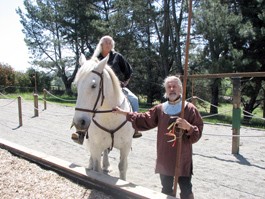05.20.09
SKILL AT ARMS: Student Diane Warner learns the fine art of 14th-century warfare from Sir William.
Astride a giant white stallion, the rider comes charging down the lane at full canter. “Allez! Allez! ” he shouts, spurring the horse on. His long mane of white hair streams behind him, and his mirror-polished armor glints in the sunlight. Sir Guillaume du Perche, better known as Sir William, expertly catches a three-inch golden ring with the tip of his lance while riding by, and smiles at his success. Dismounting from his trusty steed, Rohan, Sir William cuts a dashing figure in his brown linen tunic, tall leather boots and neatly trimmed beard. His transition from mosquito-abatement worker to stately knight is complete.
While attending a Renaissance fair a few years ago, county employee William Hamersky was intrigued by a vendor selling swords. “I picked one up and had the unique sensation that I had done this before,” he says. The sword was far more expensive than he expected. “But,” he says, “I couldn’t put it down—and ended up buying it.”
He found a school in San Jose where he studied sword fighting, learning to use the long sword, dagger and rapier. He trained for several years in jousting, skill-at-arms games and European martial arts, which include wrestling and hand-to-hand combat, especially important for self-defense and fighting in war. Gradually, William Hamersky became Sir Guillaume du Perche, Sir William for short.
“Jousting originated in the Middle Ages as practice for warfare,” he explains. “Skill-at-arms games, such as ring spearing, running the quintain, archery and spear throwing, were part of the training.” Eventually, tournaments comprising these activities were held, and knights from different countries competed for prizes. The highlight of a tournament was jousting. Initially using only a shield and helmet for protection, two knights would ride toward their opponent, trying to knock him off his horse.
Their lances weighed between 10 and 40 pounds, and were 10 to 14 feet long. In addition to being used for war training, jousting was an alternative means for settling disputes. By the 14th century, knights wore full metal armor, often weighing 90 pounds or more. The weight of man, armor and weaponry necessitated horses bred for strength and speed. Accordingly, Sir William’s steed is a 2,000-pound, 17.3-hands-high Percheron, a French working breed.
True to his heritage, Rohan is trained to respond to commands in French. A gentle giant, Rohan has learned to tolerate the noise of the armor and to be comfortable with weapons, such as spears and lances, that extend beyond his head. “You have to build up riders’ and horses’ confidence,” Sir William says. “It’s all about relationships—and horse work is one phase.”
After moving to Sebastopol two years ago, Sir William bought five acres and built a jousting list, a court outfitted with the equipment needed to practice knightly arts on horseback. He exhibits his skills at Renaissance fairs and other outdoor events, but his real passion lies in teaching. He starts students practicing archery and throwing spears while walking, until their competence increases enough to use a shield and lance and work on horseback. A balsa wood tip is used on the lance so that it shatters on contact, avoiding injury. Sir William stresses that safety is paramount.
“I teach my students how to safely hold the lance and not drop it,” he says. Students also learn to ride without reins because their hands are holding weapons. “My students are usually women in their 50s or young boys of 12,” he says. “If you’re a good horse person, it doesn’t matter your age.”
Proving Sir William’s point, fifty-something student Diane Warner arrives for her lesson. “I’m always doing things that are out of the box,” she says. “The Renaissance is an era that I’ve always dreamed about, and to actually participate is like a dream come true. Sir William is a great teacher.”
Contact Sir William and his warhorse, Rohan, for lessons or demonstrations at Full Tilt Farm, 2864 Bloomfield Road, Sebastopol. 707.827.3855.











